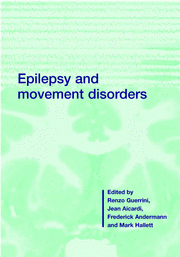Book contents
- Frontmatter
- Contents
- List of contributors
- Preface and overview
- 1 Epilepsies as channelopathies
- 2 Epilepsy and movement disorders in the GABAA receptor β3 subunit knockout mouse: model of Angelman syndrome
- 3 Genetic reflex epilepsy from chicken to man: relations between genetic reflex epilepsy and movement disorders
- 4 Functional MRI of the motor cortex
- 5 Neuromagnetic methods and transcranial magnetic stimulation for testing sensorimotor cortex excitability
- 6 Motor dysfunction resulting from epileptic activity involving the sensorimotor cortex
- 7 Nocturnal frontal lobe epilepsy
- 8 Motor cortex hyperexcitability in dystonia
- 9 The paroxysmal dyskinesias
- 10 Normal startle and startle-induced epileptic seizures
- 11 Hyperekplexia: genetics and culture-bound stimulus-induced disorders
- 12 Myoclonus and epilepsy
- 13 The spectrum of epilepsy and movement disorders in EPC
- 14 Seizures, myoclonus and cerebellar dysfunction in progressive myoclonus epilepsies
- 15 Opercular epilepsies with oromotor dysfunction
- 16 Facial seizures associated with brainstem and cerebellar lesions
- 17 Neonatal movement disorders: epileptic or non-epileptic
- 18 Epileptic and non-epileptic periodic motor phenomena in children with encephalopathy
- 19 Epileptic stereotypies in children
- 20 Non-epileptic paroxysmal eye movements
- 21 Shuddering and benign myoclonus of early infancy
- 22 Epilepsy and cerebral palsy
- 23 Sydenham chorea
- 24 Alternating hemiplegia of childhood
- 25 Motor attacks in Sturge–Weber syndrome
- 26 Syndromes with epilepsy and paroxysmal dyskinesia
- 27 Epilepsy genes: the search grows longer
- 28 Genetics of the overlap between epilepsy and movement disorders
- 29 Seizures and movement disorders precipitated by drugs
- 30 Steroid responsive motor disorders associated with epilepsy
- 31 Drugs for epilepsy and movement disorders
- Index
- Plate section
9 - The paroxysmal dyskinesias
Published online by Cambridge University Press: 03 May 2010
- Frontmatter
- Contents
- List of contributors
- Preface and overview
- 1 Epilepsies as channelopathies
- 2 Epilepsy and movement disorders in the GABAA receptor β3 subunit knockout mouse: model of Angelman syndrome
- 3 Genetic reflex epilepsy from chicken to man: relations between genetic reflex epilepsy and movement disorders
- 4 Functional MRI of the motor cortex
- 5 Neuromagnetic methods and transcranial magnetic stimulation for testing sensorimotor cortex excitability
- 6 Motor dysfunction resulting from epileptic activity involving the sensorimotor cortex
- 7 Nocturnal frontal lobe epilepsy
- 8 Motor cortex hyperexcitability in dystonia
- 9 The paroxysmal dyskinesias
- 10 Normal startle and startle-induced epileptic seizures
- 11 Hyperekplexia: genetics and culture-bound stimulus-induced disorders
- 12 Myoclonus and epilepsy
- 13 The spectrum of epilepsy and movement disorders in EPC
- 14 Seizures, myoclonus and cerebellar dysfunction in progressive myoclonus epilepsies
- 15 Opercular epilepsies with oromotor dysfunction
- 16 Facial seizures associated with brainstem and cerebellar lesions
- 17 Neonatal movement disorders: epileptic or non-epileptic
- 18 Epileptic and non-epileptic periodic motor phenomena in children with encephalopathy
- 19 Epileptic stereotypies in children
- 20 Non-epileptic paroxysmal eye movements
- 21 Shuddering and benign myoclonus of early infancy
- 22 Epilepsy and cerebral palsy
- 23 Sydenham chorea
- 24 Alternating hemiplegia of childhood
- 25 Motor attacks in Sturge–Weber syndrome
- 26 Syndromes with epilepsy and paroxysmal dyskinesia
- 27 Epilepsy genes: the search grows longer
- 28 Genetics of the overlap between epilepsy and movement disorders
- 29 Seizures and movement disorders precipitated by drugs
- 30 Steroid responsive motor disorders associated with epilepsy
- 31 Drugs for epilepsy and movement disorders
- Index
- Plate section
Summary
Introduction
Paroxysmal dyskinesias (PDs) refer to relatively brief attacks of abnormal movements and postures with return to normal between episodes. The abnormal movements consist of dystonia, choreo-athetosis, and ballism, often in combination. The duration is variable, from very short attacks lasting a few seconds to prolonged ones, lasting several hours. The frequency is variable, as is the side of the body involved. PDs can be sporadic or familial with autosomal dominant inheritance or can be symptomatic of different conditions (Bressman et al., 1988; Fahn, 1994; Demirkiran & Jankovic, 1995).
Since the first description by Mount and Reback (1940), numerous reports of patients with PDs have followed and several classifications, based on duration of attacks and etiology have been proposed (Lance, 1977; Goodenough et al., 1978; Fahn, 1994). The most recent one classifies PDs according to the precipitating events and distinguishes the following forms: paroxysmal kinesigenic dyskinesias (PKD), paroxysmal non-kinesigenic dyskinesias (PNKD), paroxysmal exertioninduced dyskinesias (PED), paroxysmal hypnogenic dyskinesias (PHD) (Demirkiran & Jankovic, 1995).
The purpose of the chapter is to describe the clinical features of the classical forms of PDs including benign paroxysmal torticollis of infants (BPT) and paroxysmal tonic up-gaze deviation of infants (PTUDI) and to review the more recent data on pathophysiology of PDs as derived from genetic studies and from animal model.
Clinical features
Paroxysmal kinesigenic dyskinesia (PKD)
Most cases of PKD are idiopathic, both familial with autosomal dominant pattern of inheritance or sporadic, but cases of symptomaticPKDare reported (Fahn, 1994; Marsden, 1996; Demirkiran & Jankovic, 1995; Hwang et al., 1998).
- Type
- Chapter
- Information
- Epilepsy and Movement Disorders , pp. 125 - 140Publisher: Cambridge University PressPrint publication year: 2001
- 2
- Cited by



